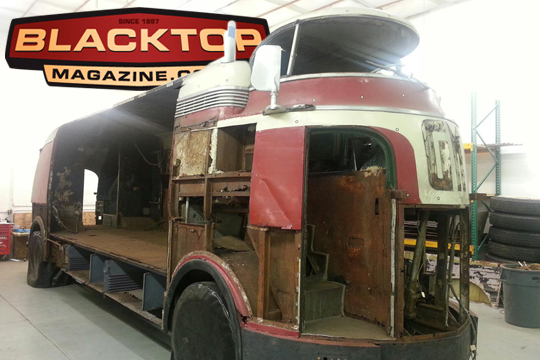Rust in Peace?? Kindig-It Design says No!!

Photos and Story provided by Kindig-it Design
In 1939, the GM Parade of Progress consisted of 12 first generation Futurliners, 8 Streamliners, 24 trucks, 19 passenger car units, 2 Army trucks (for the defense exhibit) and a couple of GM concept cars. In addition to the myriad of vehicles, they also carted around the Aer-O-Dome, a tent made specifically for the GM Parade of Progress that seated 1500 people and was built like an inverted umbrella with the ribs exposed. The Parade traveled to over 300 cities, and provided a fabulous glimpse into our technological future to over 13 million wide-eyed viewers. Even though the Parade of Progress was a huge expense to GM, I presume they would have continued offering it city by city had the invention of television not taken over the way a message was conveyed. Now companies could be in the country’s living room day after day, night after night entertaining and educating for a fraction of the cost that the Parade of Progress cost GM.
Kindig-It Design, a hot rod and restoration in Salt Lake City has the once in a lifetime opportunity of restoring a Futurliner back to her original glory for a customer. Number 3 is patiently waiting for her facelift back to the future as it were. The Futurliners are 33 feet long, 8 feet wide, 11 feet 7 inches tall with a 248-inch wheelbase. They weigh roughly 33,000 pounds and were unique for their dual side-by-side front wheels, each wheel owning its own set of brakes, brake drums and bearings. The Futurliners power steering pumps were notorious for failing because of the tremendous force necessary to turn the wheels.
In 1939, the Futurliners housed a 4-cylinder diesel engine with 4X4 mechanical transmissions; the pilot cockpit was a bubble canopy, similar to fighter planes of the era and was incredibly hot with no air conditioning. They could barely reach a top speed of 40 mph, housed two 45 gallon gas tanks, and the drivers head was at an alarming 11 feet, which made going under an overpass a terrifying experience. The brakes were not reliable, and the Futurliners often rear-ended one another, resulting in GM asking the pilots to please keep a healthy distance of 300 feet between one another. The displays had 2 massive 16X5 feet doors that opened to expose individual displays. Number 3’s display was that of a jet engine. There was a 16-foot lighting panel at the top of the overhead doors and a large light that rose from the roof another 7 feet. In order to provide the necessary electricity for the displays, each Futurliner housed a massive twin 6-71 200KW Detroit Diesel generator.
In 1953, after World War II, GM decided to make some necessary changes to the 12 Futurliners. They replaced the 4 cylinder diesel engines with a 302 inline 6 cylinder OHV GMC motor. The engine coupled to a Korean War vintage 4 speeds Hydramatic Automatic transmission bolted to the backside of another 2-speed gearbox. This gave drivers the option of selecting now from 8 forward speeds. Complicating this situation, there was another 3 speed PTO gearbox, and to shift it, the driver needed to physically leave the cockpit. And thankfully, by this time Freon had been invented, and the bubble top was replaced with a covered roof and air conditioning efficiently kept the pilots cool!
Kindig-It Design and their customer Rick White has every intention of restoring Number 3 to the way she rolled off the line in Detroit in 1939. The initial work that has started, involved taking a full inventory of what could stay, and what needed to go. When Number 3 was delivered to the shop, the exterior looked to be in good shape, but once the interior was examined, and panels removed it was obvious that she had serious rust damage. This will provide a bit more work for the crew at Kindig-It Design, because each piece that needs to be replaced must be fabricated by hand. Ryan Decol, project manager for the Futurliner task feels confident that she will be restored fully. “It is definitely a huge undertaking, but we have been very detailed and efficient dismantling the Futurliner and I have been doing the necessary homework to recreate an era specific restore.”
Stay tuned for next months feature on the Futurliner that will show the high tech tools Kindig-It Design is using to create yesterday!
Missed part 1? Check it out here.
For more info on Kindig-It Design, please visit www.kindigit.com
For more info on The GM Futurliner history visit www.futurliner.com





